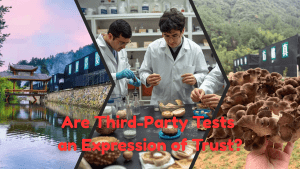September 3, 2025
By Sam Dahan, Founder, Mushroom Plenty
The Flattened World of Food—and the Rise of Mushrooms
The internet flattened the world, turning local into global almost overnight. Knowledge, once bound by borders, became limitless. Food followed. What was once seasonal or regional berries, oils, spices, herbs, even vitamins-is now accessible year-round in supermarkets from Milwaukee to Mumbai.
Yet, amidst this global pantry, mushrooms stand apart. They are not just commodities on a shelf; they are organisms that transform matter, shape ecosystems, and-most remarkably-interact with the human body in ways both measurable and mysterious.
For millennia, cultures across the world have eaten, brewed, and revered mushrooms for nourishment, ritual, and healing. In recent decades, science has joined tradition, elevating mushrooms from folklore to the focus of clinical trials. They now sit at the nexus of food and medicine, viewed simultaneously as adaptogens, nutraceuticals, and potential therapeutic allies.
Beyond the Supplement Aisle: The Adaptogenic Reality
Unlike single-target drugs, medicinal mushrooms do not lock onto a single receptor with predictable precision. They act adaptogenically-across multiple systems at once. The immune, endocrine, nervous, and metabolic networks all come into play.
This adaptogenic behavior helps explain why questions like “What’s the right dose?” or “Which mushroom is best?” have no universal answer. The answer depends on you: your physiology, your microbiome, your stress levels, your genes.
Mushrooms contain diverse bioactive compounds β-glucans, triterpenes, polysaccharides, phenolics, and more that do not simply impose effects.
They interact. They meet your body where it is, modulating rather than commanding. That is the essence of their individuality

The Journey of a Compound in the Human Body
When mushroom compounds enter the body, they embark on a well-mapped but highly individual journey described by pharmacologists as ADME: Absorption, Distribution, Metabolism, and Excretion.
Absorption Most mushroom compounds are consumed orally. Once ingested, they travel through the digestive tract, facing acidic stomach pH, neutral intestines, and the work of enzymes and bile salts. The microbiome often plays a decisive role: β-glucans, for example, are metabolized by gut microbes into bioactive fragments that interact with immune cells.
Distribution Compounds absorbed through the intestines first pass through the liver a checkpoint that can metabolize and reduce the amount entering systemic circulation (the “first-pass effect”). Those that make it through travel via blood to different tissues, guided by solubility, protein binding, and tissue affinity.
Metabolism The body then modifies these compounds, mainly in the liver. Phase I metabolism oxidizes or hydrolyzes them into more reactive molecules, while Phase II conjugation makes them more water-soluble for excretion. Depending on the compound, this can mean inactivation, bioactivation, or in rare cases toxicity.
Excretion Finally, the body clears compounds via urine (water-soluble), bile/feces (fat-soluble), or lesser routes like sweat and breath. Their persistence is measured by half-life: the time required for the concentration in plasma to fall by half.
Pharmacodynamics in Parallel While ADME explains the journey, pharmacodynamics describes the impact: β-glucans binding to dectin-1 receptors on immune cells, Reishi triterpenes modulating NF-κB pathways, or Lion’s Mane erinacines stimulating NGF production.
Why Two People Don’t Respond the Same
- Genetics – Variations in enzymes and receptors shape bioavailability.
- Microbiome – Your microbial population determines how polysaccharides are broken down.
- Lifestyle – Sleep, stress, diet, and exercise alter responsiveness.
- Preparation – Fresh, dried, hot-water, or dual extracts each deliver different compound profiles.
From Lab to Life
Both clinical research and traditional practice point in similar directions: immune regulation, cognitive support, metabolic balance, and stress adaptation. But what emerges is not uniformity it is variability.
Some lessons hold across studies and cultures:
- Consistency beats megadose benefits accrue gradually, not overnight.
- Blends outperform isolates whole mushroom powders provide fiber and prebiotics, while extracts concentrate actives.
- Tracking matters the body responds in weeks, not days; self-awareness is the best biomarker.
Nature’s Refusal of Uniformity
In a world where borders blur and supply chains standardize, medicinal mushrooms remind us that biology resists flattening. Your response to a mushroom is not anyone else’s because your body is not anyone else’s. And that individuality is where their power lies.












